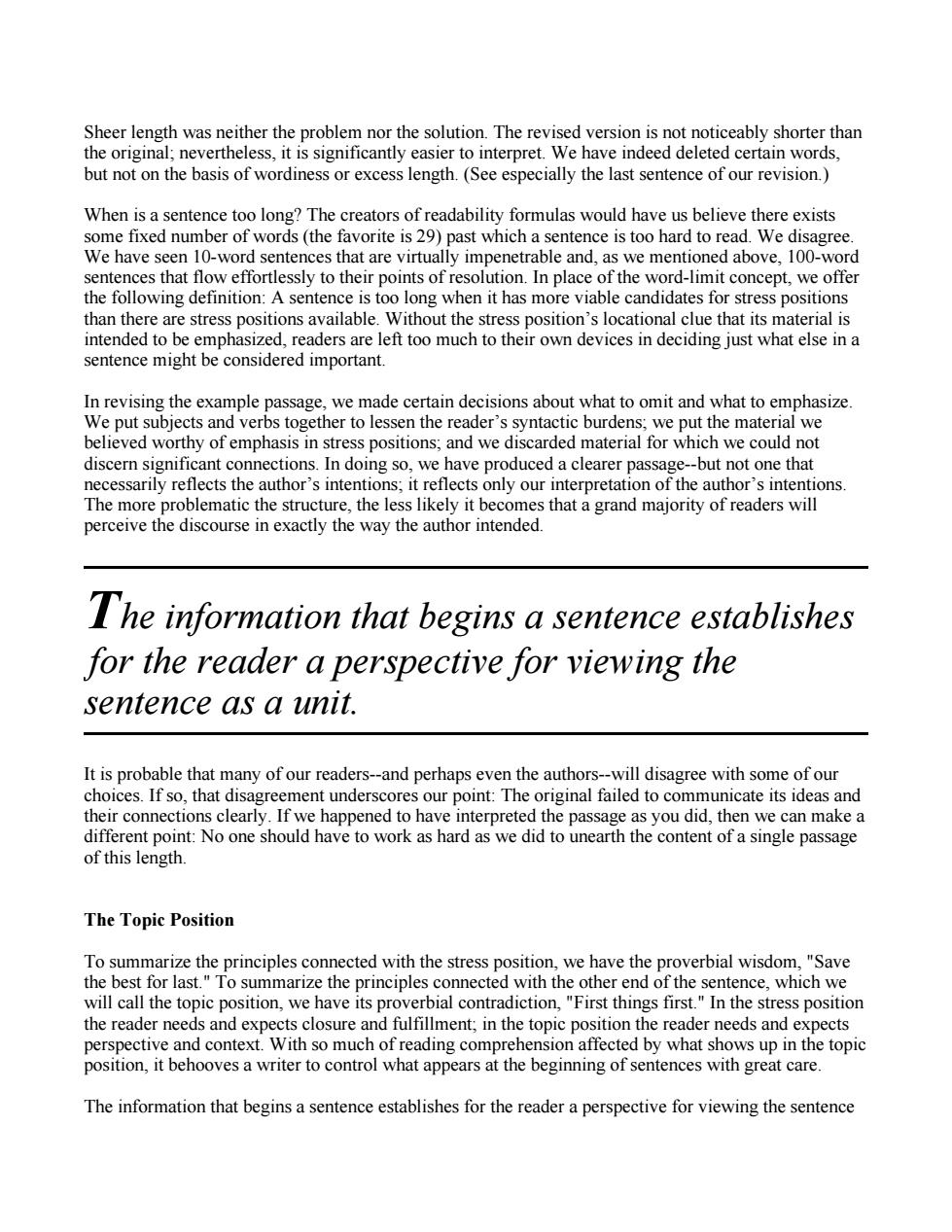正在加载图片...

Sheer length was neither the problem nor the solution.The revised version is not noticeably shorter than the original;nevertheless,it is significantly easier to interpret.We have indeed deleted certain words, but not on the basis of wordiness or excess length.(See especially the last sentence of our revision.) When is a sentence too long?The creators of readability formulas would have us believe there exists some fixed number of words (the favorite is 29)past which a sentence is too hard to read.We disagree. We have seen 10-word sentences that are virtually impenetrable and,as we mentioned above,100-word sentences that flow effortlessly to their points of resolution.In place of the word-limit concept,we offer the following definition:A sentence is too long when it has more viable candidates for stress positions than there are stress positions available.Without the stress position's locational clue that its material is intended to be emphasized,readers are left too much to their own devices in deciding just what else in a sentence might be considered important. In revising the example passage,we made certain decisions about what to omit and what to emphasize. We put subjects and verbs together to lessen the reader's syntactic burdens;we put the material we believed worthy of emphasis in stress positions;and we discarded material for which we could not discern significant connections.In doing so,we have produced a clearer passage--but not one that necessarily reflects the author's intentions;it reflects only our interpretation of the author's intentions. The more problematic the structure,the less likely it becomes that a grand majority of readers will perceive the discourse in exactly the way the author intended. The information that begins a sentence establishes for the reader a perspective for viewing the sentence as a unit. It is probable that many of our readers--and perhaps even the authors--will disagree with some of our choices.If so,that disagreement underscores our point:The original failed to communicate its ideas and their connections clearly.If we happened to have interpreted the passage as you did,then we can make a different point:No one should have to work as hard as we did to unearth the content of a single passage of this length. The Topic Position To summarize the principles connected with the stress position,we have the proverbial wisdom,"Save the best for last."To summarize the principles connected with the other end of the sentence,which we will call the topic position,we have its proverbial contradiction,"First things first."In the stress position the reader needs and expects closure and fulfillment;in the topic position the reader needs and expects perspective and context.With so much of reading comprehension affected by what shows up in the topic position,it behooves a writer to control what appears at the beginning of sentences with great care. The information that begins a sentence establishes for the reader a perspective for viewing the sentenceSheer length was neither the problem nor the solution. The revised version is not noticeably shorter than the original; nevertheless, it is significantly easier to interpret. We have indeed deleted certain words, but not on the basis of wordiness or excess length. (See especially the last sentence of our revision.) When is a sentence too long? The creators of readability formulas would have us believe there exists some fixed number of words (the favorite is 29) past which a sentence is too hard to read. We disagree. We have seen 10-word sentences that are virtually impenetrable and, as we mentioned above, 100-word sentences that flow effortlessly to their points of resolution. In place of the word-limit concept, we offer the following definition: A sentence is too long when it has more viable candidates for stress positions than there are stress positions available. Without the stress position’s locational clue that its material is intended to be emphasized, readers are left too much to their own devices in deciding just what else in a sentence might be considered important. In revising the example passage, we made certain decisions about what to omit and what to emphasize. We put subjects and verbs together to lessen the reader’s syntactic burdens; we put the material we believed worthy of emphasis in stress positions; and we discarded material for which we could not discern significant connections. In doing so, we have produced a clearer passage--but not one that necessarily reflects the author’s intentions; it reflects only our interpretation of the author’s intentions. The more problematic the structure, the less likely it becomes that a grand majority of readers will perceive the discourse in exactly the way the author intended. The information that begins a sentence establishes for the reader a perspective for viewing the sentence as a unit. It is probable that many of our readers--and perhaps even the authors--will disagree with some of our choices. If so, that disagreement underscores our point: The original failed to communicate its ideas and their connections clearly. If we happened to have interpreted the passage as you did, then we can make a different point: No one should have to work as hard as we did to unearth the content of a single passage of this length. The Topic Position To summarize the principles connected with the stress position, we have the proverbial wisdom, "Save the best for last." To summarize the principles connected with the other end of the sentence, which we will call the topic position, we have its proverbial contradiction, "First things first." In the stress position the reader needs and expects closure and fulfillment; in the topic position the reader needs and expects perspective and context. With so much of reading comprehension affected by what shows up in the topic position, it behooves a writer to control what appears at the beginning of sentences with great care. The information that begins a sentence establishes for the reader a perspective for viewing the sentence